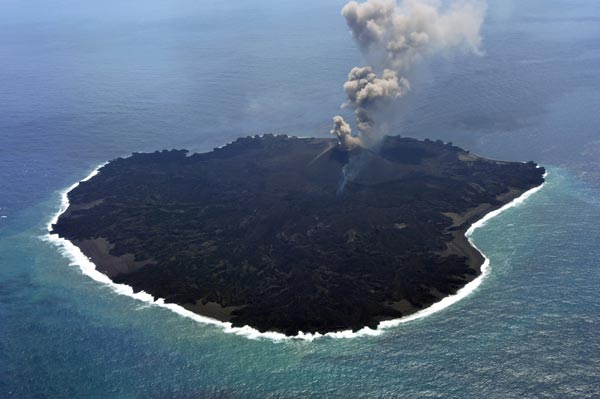
Smoke rises from the new Nishinoshima island, a volcanic speck in the Pacific that scientists say will help them to understand how life colonizes barren land. Japan Coast Guard / Agence France-Presse
A brand new island emerging off the coast of Japan offers scientists a rare opportunity to study how life begins to develop on barren land - helped by rotting bird droppings and hatchling vomit.
Researchers say bird waste will be the secret ingredient to kick-start nature's colonization of what is still an active volcano that only poked its head above the waves in November 2013.
The speck of land 1,000 km south of Tokyo has grown to engulf its once larger neighbor, Nishinoshima, a part of Japan's Ogasawara island chain known for the wealth and variety of its ecosystem.
The new Nishinoshima measures 2.46 square km - roughly equivalent to 345 soccer fields - the Japan Coast Guard said in February, and it is currently almost all bare rock, formed from cooling lava.
But scientists say it will one day be covered with plant - and possibly animal - life, as nature moves in to what is being called a "natural laboratory" on one of the newest bits of real estate in the Pacific Ocean.
"We biologists are very much focusing on the new island because we'll be able to observe the starting point of evolutionary processes," said Naoki Kachi, professor and leader of Tokyo Metropolitan University's Ogasawara Research Committee.
After the volcanic activity calms down, "what will probably happen first will be the arrival of plants brought by ocean currents and attached to birds' feet", he said.
Those seabirds, who could use the remote rock as a temporary resting place, could eventually set up home there.
Their excrement - along with their dropped feathers, regurgitated bits of food and rotting corpses - will eventually form a nutrient-rich soil that offers fertile ground for seeds carried by the wind, or brought in the digestive systems of overflying birds.
"I am most interested in the effects of birds on the plants' ecosystem - how their bodily wastes-turned-organic fertilizers enrich the vegetation and how their activities disturb it," Kachi said.
The old Nishinoshima, measuring just 0.22 sq km, was home to bird colonies until the eruptions scared most of them away.
A small number have clung on to the only patch of the old island that is still visible, making their nests among ash-covered plants.